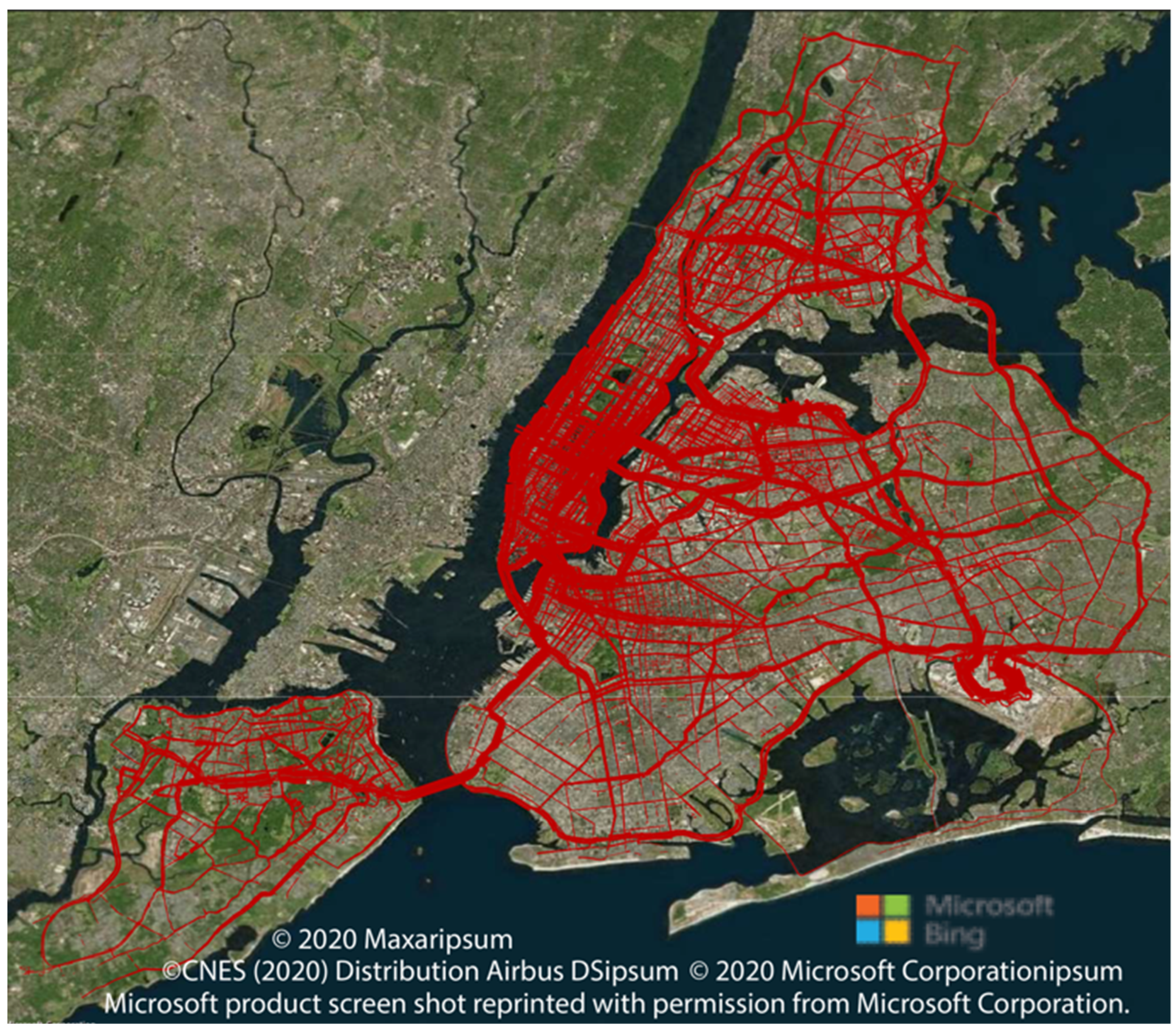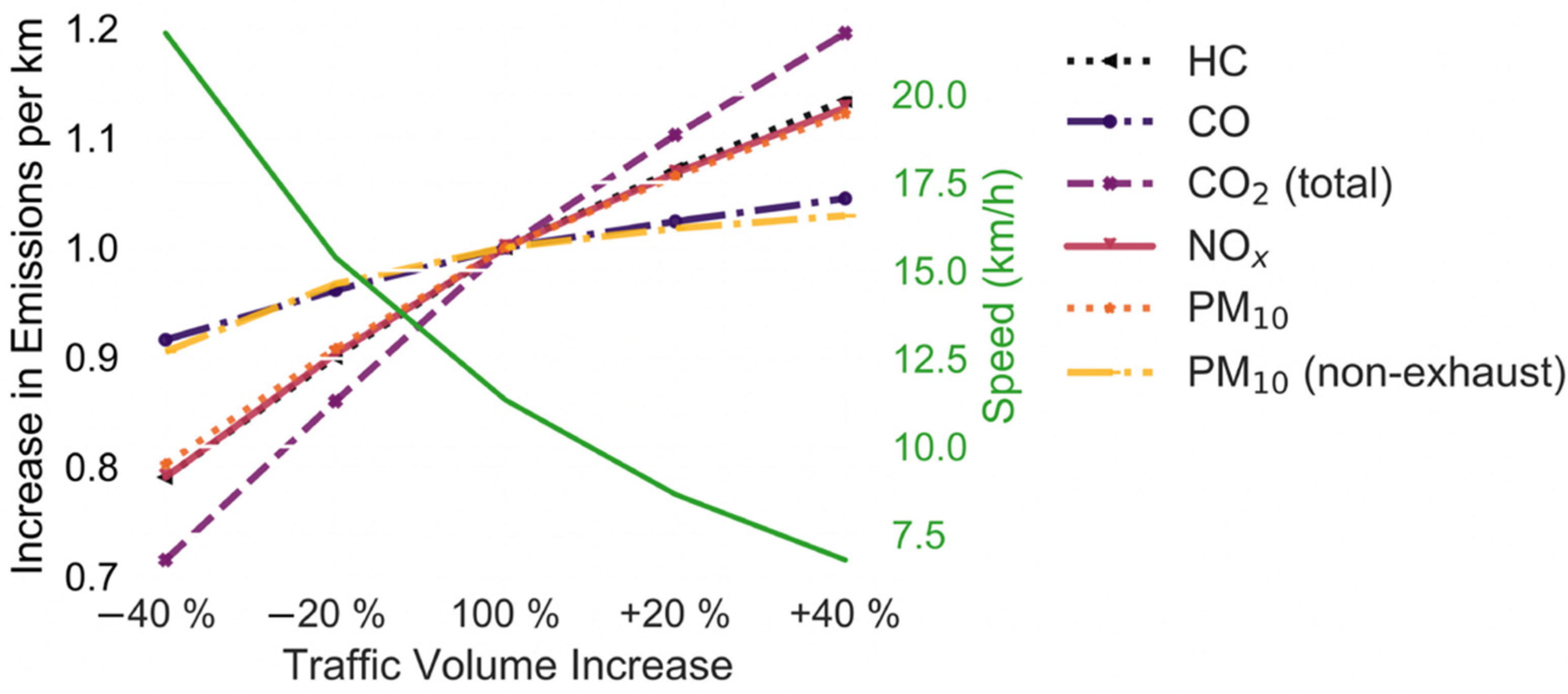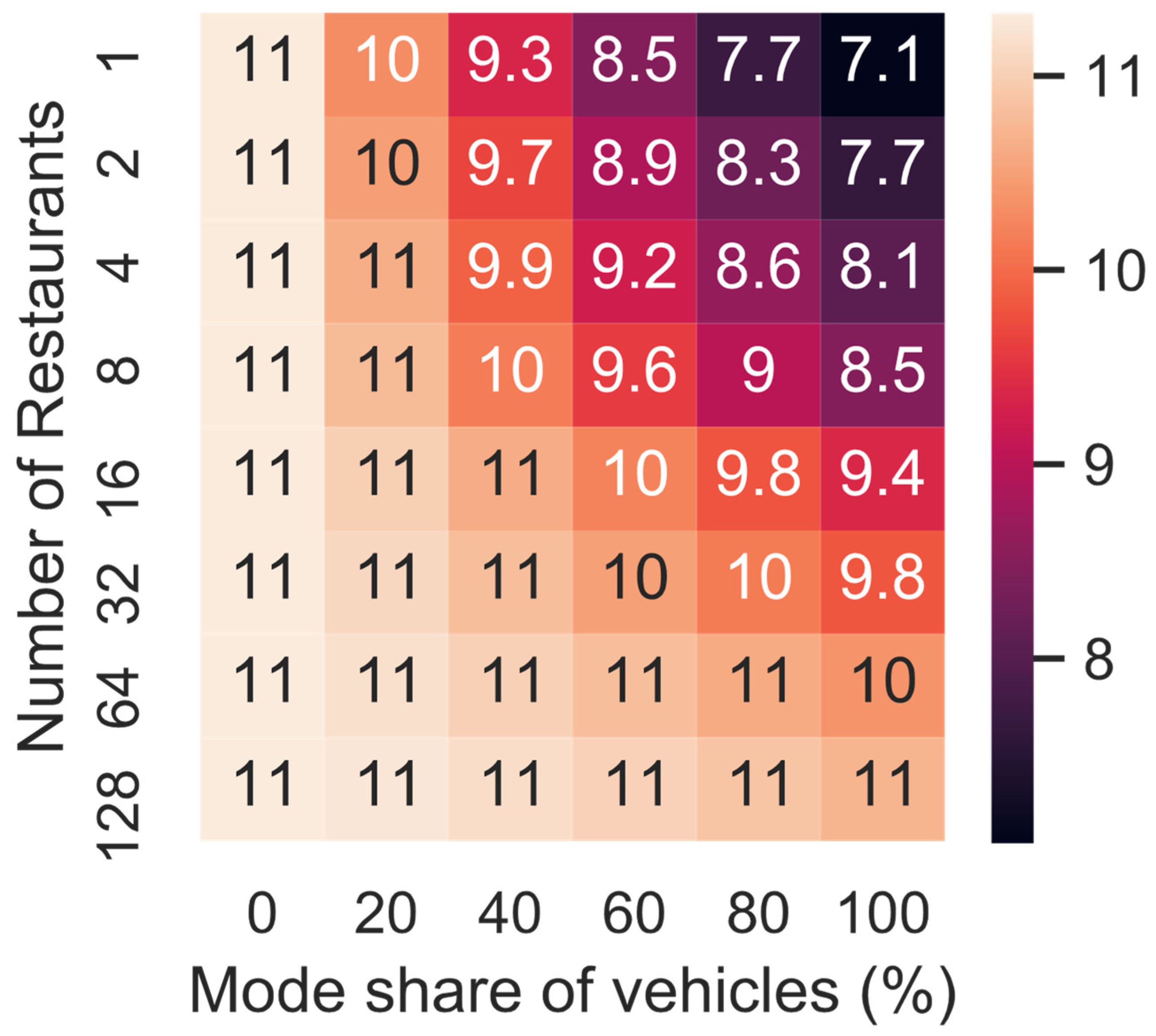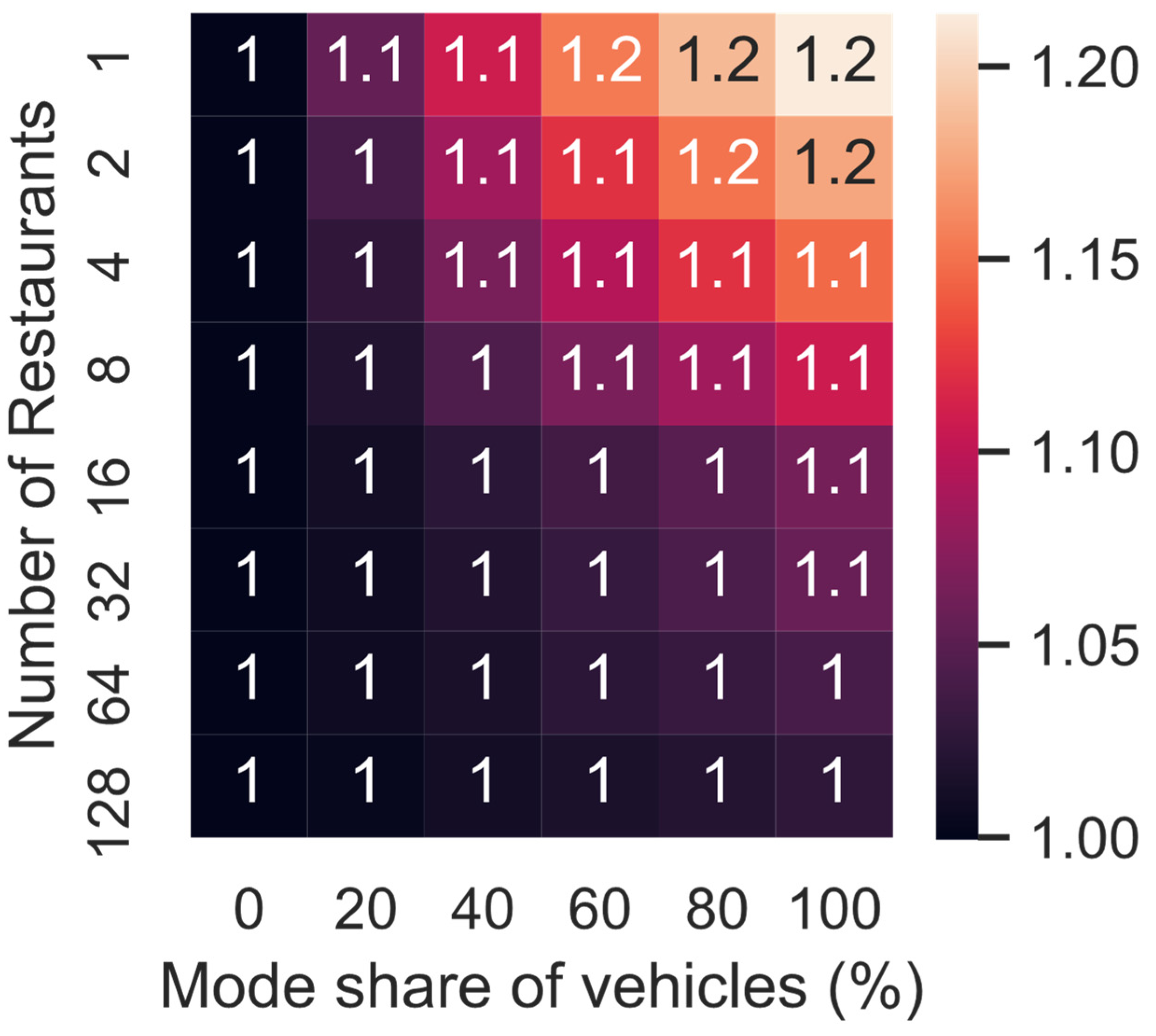Emission Estimation of On-Demand Meal Delivery Services Using a Macroscopic Simulation
Abstract
1. Introduction
- Even though the relationship between emissions and congestion has been demonstrated in the literature [14], simulations of parcel delivery to lockers and meal delivery generally assume that the traffic flow will be the same regardless of the changes in the delivery service [13]. In contrast, this study considers that changes in the last mile delivery will affect the traffic flow, and therefore, the emissions. This study uses a similar methodology to calculate the emissions as in Tang et al. [12]. However, this study highlights the importance of adjusting emission factors depending on the traffic flow instead of only using average values. Other research has been focused on quantifying the total emissions, while this study highlights the increase in emissions per km. It is obvious that the emissions surge when the distance travelled increases. However, excessive congestion increases the emissions per km. Hence, the total emissions would be underestimated if a constant emission factor (i.e., g/km) is assumed.
- This study compares tour based with direct on-demand meal delivery services. In the first option, the meals are combined into a delivery tour while in the second option each meal order is distributed as a direct roundtrip between the restaurants and the customers.
- This study contributes to the research domain by analysing the effect the delivery network density (i.e., number of restaurants), as well as changes in the mode share for cars will have on the traffic flow and emissions.
- Emission estimation based on macroscopic traffic simulations can be calculated for each individual link (i.e., street, e.g., [4,14]), while emission simulations of delivery to parcel lockers are usually calculated per trip (see literature review in [13]). The study links both methods by comparing link-based emission estimates with OD-pair (i.e., origin and destination) based emission estimates.
- This study also highlights the difference in the results if the average speed is used as an explanatory variable for emission factors (e.g., in [12], referred to as OD-pair based) instead of using traffic flow and road type (referred to as link based). This is an important consideration given that 50 km/h might be the free-flow speed in a city but on a motorway, 50 km/h would indicate a saturated traffic flow.
- Other authors, such as Heldt et al. [15], simulate passenger transport in one model and deliveries in another model (i.e., no interaction between both). In contrast, this study optimises the delivery trips independently to ease the simulation but then aggregates the delivery trip demand in addition to the passenger vehicle demand into the same macroscopic simulation.
2. Literature Review
- Conducted a traffic simulation in PTV VISUM.
- Focus amongst other things on freight transport on roads in their simulation and not on freight transport on rail/cargo trains or intermodal transport.
3. Methods: On-Demand Meal Delivery (OD-Pair Based)
3.1. Overview
3.2. Traffic Network and Transport Demand by Cars
3.3. Delivery Network and On-Demand Meal Delivery Demand
3.4. Scenarios
3.5. Assignment
3.6. Emission Modelling HBEFA
3.7. Limitations
4. Results: On-Demand Meal Delivery (OD-Pairs)
4.1. FHV Trip Data
4.2. Scenario 1
4.3. Scenario 2
4.4. Scenario 3
5. Methods: On-Demand Meal Delivery (Links)
5.1. Traffic Network, Demand and Assignment
5.2. Emission Modelling HBEFA
6. Results: On-Demand Meal Delivery (Link Based)
6.1. Scenario 1
6.1.1. Link-Based and One Street Type vs. OD-Pair Based
6.1.2. Link-Based and Correct Street Types vs. OD-Pair Based
6.1.3. Link-Based and Correct Street Types vs. Link-Based and One Street Type
7. Discussion
8. Future Work
9. Conclusions
Author Contributions
Funding
Institutional Review Board Statement
Informed Consent Statement
Data Availability Statement
Acknowledgments
Conflicts of Interest
References
- Toilier, F.; Gardrat, M.; Routhier, J.L.; Bonnafous, A. Freight transport modelling in urban areas: The French case of the FRETURB model. Case Stud. Transp. Policy 2018, 6, 753–764. [Google Scholar] [CrossRef]
- Gupta, S.; Sinha, K. Characteristics of urban freight traffic in a medium size Indian city—A case study of Udaipur, Rajasthan. Transp. Res. Procedia 2020, 48, 503–521. [Google Scholar] [CrossRef]
- Bonnafous, A.; Gonzalez-feliu, J.; Routhier, J.; Bonnafous, A.; Gonzalez-feliu, J.; An, J.R. An alternative UGM Paradigm to O-D matrices: The FRETURB model. In Proceedings of the WCTR 2013, Rio de Janeiro, Brazil, 15–18 July 2013. 21p. [Google Scholar]
- Rodriguez-Rey, D.; Guevara, M.; Linares, M.P.; Casanovas, J.; Salmerón, J.; Soret, A.; Jorba, O.; Tena, C.; Pérez García-Pando, C. A coupled macroscopic traffic and pollutant emission modelling system for Barcelona. Transp. Res. Part D Transp. Environ. 2021, 92, 102725. [Google Scholar] [CrossRef]
- Liu, C.; Wang, Q.; Susilo, Y.O. Assessing the impacts of collection-delivery points to individual’s activity-travel patterns: A greener last mile alternative? Transp. Res. Part E Logist. Transp. Rev. 2019, 121, 84–99. [Google Scholar] [CrossRef]
- Weiss, C.; Onnen-Weber, U. The challenge of sustainable last mile distribution of CEP services in small towns. Transp. Res. Procedia 2019, 39, 597–604. [Google Scholar] [CrossRef]
- Moroz, M.; Polkowski, Z. The Last Mile Issue and Urban Logistics: Choosing Parcel Machines in the Context of the Ecological Attitudes of the Y Generation Consumers Purchasing Online. Transp. Res. Procedia 2016, 16, 378–393. [Google Scholar] [CrossRef]
- Iwan, S.; Kijewska, K.; Lemke, J. Analysis of Parcel Lockers’ Efficiency as the Last Mile Delivery Solution—The Results of the Research in Poland. Transp. Res. Procedia 2016, 12, 644–655. [Google Scholar] [CrossRef]
- Jiang, L.; Chang, H.; Zhao, S.; Dong, J.; Lu, W. A Travelling Salesman Problem with Carbon Emission Reduction in the Last Mile Delivery. IEEE Access 2019, 7, 61620–61627. [Google Scholar] [CrossRef]
- Jiang, X.; Ma, J.; Zhu, H.; Guo, X.; Huang, Z. Evaluating the carbon emissions efficiency of the logistics industry based on a super-sbm model and the malmquist index from a strong transportation strategy perspective in China. Int. J. Environ. Res. Public Health 2020, 17, 8459. [Google Scholar] [CrossRef] [PubMed]
- Otto, M.; Ramacher, P.; Matthias, V.; Aulinger, A.; Quante, M.; Bieser, J.; Karl, M. Contributions of traffic and shipping emissions to city-scale NOx and PM2.5 exposure in Hamburg. Atmos. Environ. 2020, 237, 117674. [Google Scholar] [CrossRef]
- Tang, J.; McNabola, A.; Misstear, B.; Caulfield, B. An evaluation of the impact of the Dublin Port Tunnel and HGV management strategy on air pollution emissions. Transp. Res. Part D Transp. Environ. 2017, 52, 1–14. [Google Scholar] [CrossRef]
- Schnieder, M.; Hinde, C.; West, A. Sensitivity analysis of emission models of parcel lockers vs. Home delivery based on hbefa. Int. J. Environ. Res. Public Health 2021, 18, 6325. [Google Scholar] [CrossRef] [PubMed]
- Wu, K.; Chen, Y.; Ma, J.; Bai, S.; Tang, X. Traffic and emissions impact of congestion charging in the central Beijing urban area: A simulation analysis. Transp. Res. Part D Transp. Environ. 2017, 51, 203–215. [Google Scholar] [CrossRef]
- Heldt, B.; Matteis, T.; von Schmidt, A.; Heinrichs, M. Cool but dirty food?—Estimating the impact of grocery home delivery on transport and CO2 emissions including cooling. Res. Transp. Econ. 2021, 87, 100763. [Google Scholar] [CrossRef]
- Schnieder, M.; Hinde, C.; West, A. Land consumption of delivery robots and bicycle couriers for on-demand meal delivery using gps data and simulations based on the time-area concept. Sustainability 2021, 13, 11375. [Google Scholar] [CrossRef]
- Gyergyay, B.; Gomari, S.; Friedrich, M.; Sonnleitner, J.; Olstam, J.; Johansson, F. Automation-ready framework for urban transport and road infrastructure planning. Transp. Res. Procedia 2019, 41, 88–97. [Google Scholar] [CrossRef]
- Page, M.J.; McKenzie, J.E.; Bossuyt, P.M.; Boutron, I.; Hoffmann, T.C.; Mulrow, C.D.; Shamseer, L.; Tetzlaff, J.M.; Akl, E.A.; Brennan, S.E.; et al. The PRISMA 2020 statement: An updated guideline for reporting systematic reviews. Syst. Rev. 2021, 372, 89. [Google Scholar] [CrossRef]
- Perera, L.; Thompson, R.G.; Wu, W. A multi-class toll-based approach to reduce total emissions on roads for sustainable urban transportation. Sustain. Cities Soc. 2020, 63, 102435. [Google Scholar] [CrossRef]
- Perera, L.; Thompson, R.G.; Wu, W. Toll and subsidy for freight vehicles on urban roads: A policy decision for City Logistics. Res. Transp. Econ. 2021, 90, 101132. [Google Scholar] [CrossRef]
- Gorin, E.; Morozova, Y.; Zatsepin, A.; Ryabchikov, D. Improving the method of freight vehicles’ traffic modeling. Transp. Res. Procedia 2018, 36, 213–219. [Google Scholar] [CrossRef]
- Martino, A.; Williams, I.; Fiorello, D.; Noekel, K.; Capros, P.; Siskos, P.; Zazias, G.; Charalampidis, I.; Panagiotis, K.; Schade, W. TRIMODE: Integrated transport model for Europe. In Proceedings of the 7th Transport Research Arena TRA 2018, Vienna, Austria, 16–19 April 2018. [Google Scholar]
- Fiorello, D.; Nökel, K.; Martino, A. The TRIMODE integrated model for Europe. Transp. Res. Procedia 2018, 31, 88–98. [Google Scholar] [CrossRef]
- Grebe, S.; de Jong, G.; Wampera, C.; Obermayer, C.; Pompl, R. VMÖ—A new strategic transport model for Austria. Transp. Res. Procedia 2020, 49, 95–106. [Google Scholar] [CrossRef]
- Roider, O.; Sammer, G.; Link, C.; Bauer, R.; Schachinger, W. An innovative integration methodology of independent data sources to improve the quality of freight transport surveys. Transp. Res. Procedia 2015, 11, 515–530. [Google Scholar] [CrossRef][Green Version]
- Savadogo, I.; Beziat, A. Evaluating the potential environmental impacts of a large scale shift to off-hour deliveries. Transp. Res. Part D Transp. Environ. 2021, 90, 102649. [Google Scholar] [CrossRef]
- Jacyna, M.; Wasiak, M.; Lewczuk, K.; Chamier-Gliszczyński, N.; Dqbrowski, T. Decision problems in developing proecological transport system. Rocznik Ochrona Środowiska 2018, 20, 1007–1025. [Google Scholar]
- Gnap, J.; Senko, Š.; Drliciak, M.; Kostrzewski, M. Modeling of time availability of intermodal terminals. Transp. Res. Procedia 2021, 55, 442–449. [Google Scholar] [CrossRef]
- Binh, N.T. Forecasting Logistics Demand on Strategic Transport Corridors Based on VISUM—Case Study of Hanoi-Lao Cai Transport Corridor of Vietnam; Springer: Singapore, 2022; Volume 203, ISBN 9789811671593. [Google Scholar]
- Waskom, M.; Botvinnik, O.; Hobson, P.; Cole, J.B.; Halchenko, Y.; Hoyer, S.; Miles, A.; Augspurger, T.; Yarkoni, T.; Megies, T.; et al. Seaborn: v0.5.0 (November 2014); Zenodo. 2014. Available online: https://zenodo.org/record/12710#.YyMXX-zMJQJ (accessed on 22 April 2019).
- Hunter, J.D. Matplotlib: A 2D Graphics Environment. Comput. Sci. Eng. 2007, 9, 90–95. [Google Scholar] [CrossRef]
- OpenStreetMap Contributors. Planet Dump. 2019. Available online: https://planet.openstreetmap.org (accessed on 1 May 2019).
- City of New York. TLC Trip Record Data—TLC. Available online: https://www1.nyc.gov/site/tlc/about/tlc-trip-record-data.page (accessed on 9 May 2021).
- Department of Transportation. Citywide Mobility Survey—Main Survey | NYC Open Data. 2017. Available online: https://data.cityofnewyork.us/Transportation/Citywide-Mobility-Survey-Main-Survey/dd6w-hnq9 (accessed on 13 February 2019).
- NYC Department of Transportation. New York City Mobility Report. 2019. Available online: http://www.nyc.gov/html/dot/downloads/pdf/mobility-report-2019-print.pdf (accessed on 5 May 2020).
- QGIS Development Team. QGIS Geographic Information System. 2019. Available online: https://qgis.org/en/site/ (accessed on 1 December 2019).
- Department of Information Technology and Telecommunications (DoITT). NYC Address Points | NYC Open Data. 2019. Available online: https://data.cityofnewyork.us/City-Government/NYC-Address-Points/g6pj-hd8k (accessed on 5 February 2019).
- Department of City Planning (DCP). Census Demographics at the Neighborhood Tabulation Area (NTA) Level | NYC Open Data. 2018. Available online: https://data.cityofnewyork.us/City-Government/Census-Demographics-at-the-Neighborhood-Tabulation/rnsn-acs2 (accessed on 17 April 2019).
- Harris, C.R.; Millman, K.J.; van der Walt, S.J.; Gommers, R.; Virtanen, P.; Cournapeau, D.; Wieser, E.; Taylor, J.; Berg, S.; Smith, N.J.; et al. Array programming with NumPy. Nature 2020, 585, 357–362. [Google Scholar] [CrossRef]
- Luxen, D.; Vetter, C. Real-Time Routing with OpenStreetMap Data. In Proceedings of the 19th ACM SIGSPATIAL International Conference on Advances in Geographic Information Systems, Chicago, IL, USA, 1–4 November 2011; Association for Computing Machinery: New York, NY, USA, 2011; pp. 513–516. [Google Scholar]
- Notter, B.; Keller, M.; Cox, B. HBEFA (Handbook Emission Factors for Road Transport) 4.1 Development Report Quick Reference. 2019. Available online: https://www.hbefa.net/e/help/HBEFA41_help_en.pdf (accessed on 10 October 2019).
- Rosero, F.; Fonseca, N.; López, J.M.; Casanova, J. Effects of passenger load, road grade, and congestion level on real-world fuel consumption and emissions from compressed natural gas and diesel urban buses. Appl. Energy 2021, 282, 116195. [Google Scholar] [CrossRef]
- Smit, R.; Ntziachristos, L.; Boulter, P. Validation of road vehicle and traffic emission models—A review and meta-analysis. Atmos. Environ. 2010, 44, 2943–2953. [Google Scholar] [CrossRef]
- Samaras, C.; Tsokolis, D.; Toffolo, S.; Magra, G.; Ntziachristos, L.; Samaras, Z. Enhancing average speed emission models to account for congestion impacts in traffic network link-based simulations. Transp. Res. Part D Transp. Environ. 2019, 75, 197–210. [Google Scholar] [CrossRef]
- Smit, R.; Brown, A.L.; Chan, Y.C. Do air pollution emissions and fuel consumption models for roadways include the effects of congestion in the roadway traffic flow? Environ. Model. Softw. 2008, 23, 1262–1270. [Google Scholar] [CrossRef]









| Street Network | Traffic/Freight Data | Emissions | |
|---|---|---|---|
| Perera et al. [19] | OpenStreetMap (minor local roads were excluded) | real traffic volumes (Average Annual Daily Traffic—AADT) | Emission costs |
| Perera et al. [20] | OpenStreetMap (minor local roads were excluded) | real traffic volumes (Average Annual Daily Traffic—AADT) | Emission costs |
| Gorin et al. [21] | Constructed by authors | four-step model (based on workplaces of each vehicle capacity per zone) | - |
| Gupta et al. [2] | Constructed by authors | four-step model (based on origin and destination surveys) | CO, HC, NOx, PM, etc. a |
| Tang et al. [12] | Map in VISUM, National Transport Model (NTpM) of Ireland | National Traffic Model (NTM) of Ireland and NTpM (NRA), Traffic count records | CO, CH4, NOx, PM, CO2 |
| Martino et al. [22] Fiorello et al. [23] | Based on network model | Based on economy model and energy model | - |
| Grebe et al. [24] | Graphic Integration Platform, OpenStreetMap | Revealed preference and stated preference surveys | - |
| Roider et al. [25] | Austrian transport model | Various freight transport statistics, road toll, vehicle count | - |
| Savadogo et al. [26] | - | SIMBAD, FRETURB | CO2, CO, PM, NOx, VOC a |
| Jacyna et al. [27] | Constructed by authors | average daily traffic (ADT) and nominal hourly traffic volumes | CO, HC, NOx, |
| Gnap et al. [28] | - | transport model of the Žilina self-governing region | - |
| Binh [29] | - | data from the General Statistic Office of Vietnam, survey of 144 export-import and logistics companies | - |
| Origin/Destination | A | B | C |
|---|---|---|---|
| A | 3 | 1 | 0 |
| B | 0 | 3 | 1 |
| C | 1 | 0 | 4 |
| Pollutant | Traffic Demand | ||||
|---|---|---|---|---|---|
| 60% | 80% | 100% | 120% | 140% | |
| HC | 0.88 | 0.87 | 0.85 | 0.86 | 0.85 |
| CO | 0.87 | 0.89 | 0.90 | 0.91 | 0.92 |
| CO2 (total) | 0.88 | 0.85 | 0.83 | 0.82 | 0.82 |
| NOx | 0.88 | 0.86 | 0.85 | 0.86 | 0.86 |
| PM10 | 0.88 | 0.87 | 0.86 | 0.86 | 0.86 |
| PM10 (non-exhaust) | 0.88 | 0.88 | 0.90 | 0.91 | 0.92 |
| Pollutant | Traffic Demand | ||||
|---|---|---|---|---|---|
| 60% | 80% | 100% | 120% | 140% | |
| HC | 1.00 | 0.97 | 0.93 | 0.92 | 0.94 |
| CO | 1.48 | 1.44 | 1.40 | 1.40 | 1.41 |
| CO2 (total) | 0.86 | 0.82 | 0.77 | 0.76 | 0.79 |
| NOx | 0.78 | 0.76 | 0.74 | 0.73 | 0.74 |
| PM10 | 0.95 | 0.93 | 0.91 | 0.91 | 0.92 |
| PM10 (non-exhaust) | 0.80 | 0.78 | 0.77 | 0.77 | 0.77 |
| Pollutant | Traffic Demand | ||||
|---|---|---|---|---|---|
| 60% | 80% | 100% | 120% | 140% | |
| HC | 0.88 | 0.90 | 0.91 | 0.92 | 0.93 |
| CO | 0.59 | 0.62 | 0.64 | 0.65 | 0.66 |
| CO2 (total) | 1.02 | 1.04 | 1.05 | 1.06 | 1.07 |
| NOx | 1.13 | 1.14 | 1.15 | 1.16 | 1.17 |
| PM10 | 0.93 | 0.93 | 0.94 | 0.94 | 0.95 |
| PM10 (non-exhaust) | 1.10 | 1.14 | 1.16 | 1.18 | 1.19 |
Publisher’s Note: MDPI stays neutral with regard to jurisdictional claims in published maps and institutional affiliations. |
© 2022 by the authors. Licensee MDPI, Basel, Switzerland. This article is an open access article distributed under the terms and conditions of the Creative Commons Attribution (CC BY) license (https://creativecommons.org/licenses/by/4.0/).
Share and Cite
Schnieder, M.; Hinde, C.; West, A. Emission Estimation of On-Demand Meal Delivery Services Using a Macroscopic Simulation. Int. J. Environ. Res. Public Health 2022, 19, 11667. https://doi.org/10.3390/ijerph191811667
Schnieder M, Hinde C, West A. Emission Estimation of On-Demand Meal Delivery Services Using a Macroscopic Simulation. International Journal of Environmental Research and Public Health. 2022; 19(18):11667. https://doi.org/10.3390/ijerph191811667
Chicago/Turabian StyleSchnieder, Maren, Chris Hinde, and Andrew West. 2022. "Emission Estimation of On-Demand Meal Delivery Services Using a Macroscopic Simulation" International Journal of Environmental Research and Public Health 19, no. 18: 11667. https://doi.org/10.3390/ijerph191811667
APA StyleSchnieder, M., Hinde, C., & West, A. (2022). Emission Estimation of On-Demand Meal Delivery Services Using a Macroscopic Simulation. International Journal of Environmental Research and Public Health, 19(18), 11667. https://doi.org/10.3390/ijerph191811667






